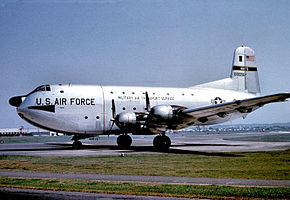1503rd Air Transport Wing
| 1503d Air Transport Wing | |
|---|---|

MATS C-124A Globemaster II 50-1256
|
|
| Active | 1948–1964 |
| Country | United States |
| Branch | United States Air Force |
| Type | Airlift |
| Insignia | |
| 1503d Air Transport Wing emblem |  |
The 1503d Air Transport Wing is an inactive United States Air Force unit. It was last assigned to Western Transport Air Force of Military Air Transport Service at Tachikawa Air Base, Japan. It was inactivated on 22 June 1964 and its remaining squadron transferred to the 1503d Air Transport Group.
The wing was first organized in at Haneda Air Base in June 1948 as the 540th Air Transport Wing by Military Air Transport Service (MATS). Along with its subordinate units, it replaced the 22d Air Transport Group (Provisional) and absorbed the personnel and equipment of the 1539th Air Force Base Unit of Air Transport Command, which had been stationed at Haneda since the summer of 1946. The wing was soon renamed the 1503d Air Transport Wing to comply with United States Air Force requirements that MATS units be numbered between 1200 and 2199.
The 1503d became the main MATS organization in the Western Pacific, supporting numerous tenant organizations such as the Air Rescue Service; Air Weather Service, and Far East Air Force theater Troop Carrier Groups (later Wings) which transshipped supplies and personnel from the MATS Aerial Port at Tachikawa throughout the 1950s.
The first major mission by the 1503d was the evacuation of large numbers of Americans out of China in 1948 after the Communists defeated the Chinese Nationalist forces during the Chinese Civil War.
The Korean War saw operations increase, with Troop Carrier units carrying out the evacuation of American civilians and then transporting the torrent of Allied military men and material flowing into the war zone. Around the clock planes arrived and departed. A typical flight might carry 35,000 pounds of hand grenades to South Korea, with 80 wounded personnel arriving to be transported to the USAF Hospital on the base. For thousands of servicemen whose tours took them into, through or out of Tachikawa, the USAF hospital became the best barometer of American military activities in the Far East.
...
Wikipedia
